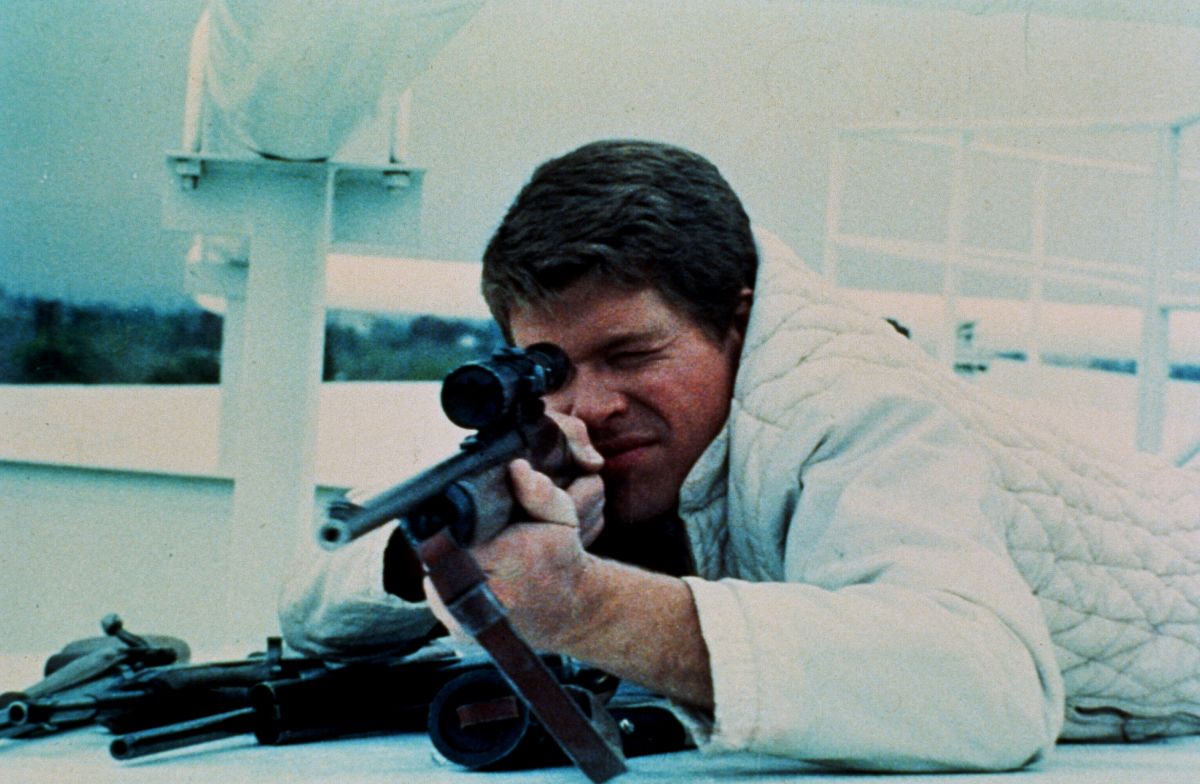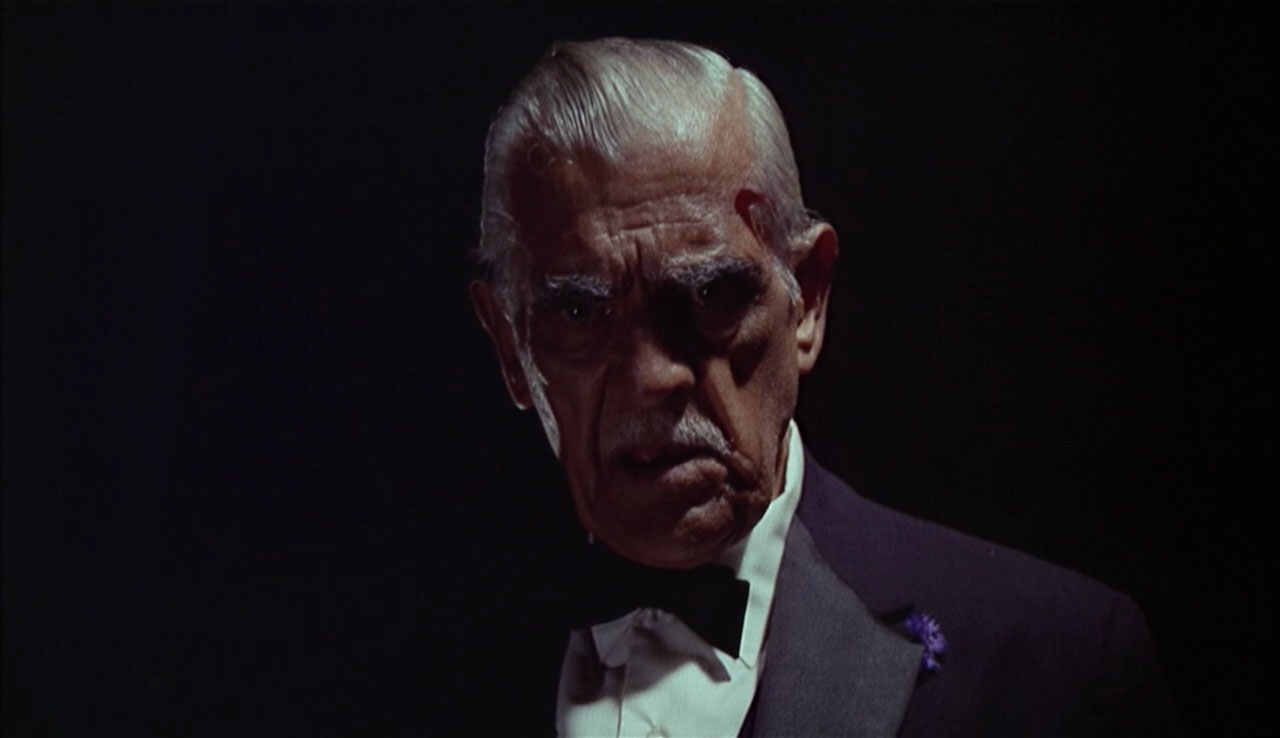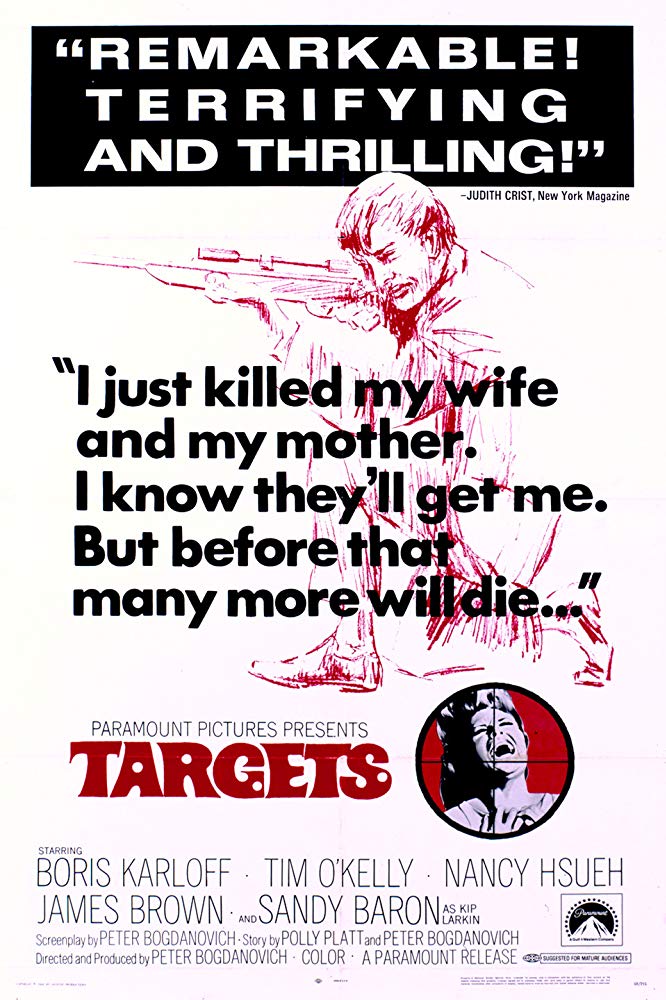aka Before I Die
Crew
Director/Screenplay/Producer – Peter Bogdanovich, Story – Peter Bogdanovich & Polly Platt, Photography – Laszlo Kovacs, Production Design – Polly Platt. Production Company – Saticoy Productions.
Cast
Boris Karloff (Byron Orlok), Tim O’Kelly (Bobby Thompson), Peter Bogdanovich (Sammy Michaels), Nancy Hsueh (Jenny), Tanya Morgan (Ilene Thompson), James Brown (Robert Thompson Sr)
Plot
After a studio screening of his latest film, aging horror star Byron Orlok announces that he is going to retire, believing that he is now an anachronism compared to the violence on the streets. Young director Sammy Michaels, hoping to persuade Orlok to star in his script, tries to convince him otherwise. At the same time, average young insurance salesman Bobby Thompson takes his collection of guns and unexpectedly blows away his mother, followed by his wife and a delivery boy. He then climbs a gas tower and start sniping at motorists on the freeway. Fleeing from police, Bobby takes refuge at the drive-in cinema where Orlok has come to make his last appearance and begins shooting at the attendees from behind the screen.
Targets was an impressive debut feature from the bright and talented director Peter Bogdanovich. Bogdanovich had started proramming film screenings at the New York Museum of Modern Art, then moved to Hollywood and obtained a job as assistant editor for Roger Corman on The Wild Angels (1966), before being given the opportunity to direct the English language segments for Voyage to the Planet of Prehistoric Women (1968), one of several films that Roger Corman had pieced together out of footage taken from Russian sf films. Targets came about because Boris Karloff still owed Corman several days on a contract from The Terror (1963). Corman purportedly told Peter Bogdanovich to create a vehicle to use up Karloff’s remaining three days, as well as to come up with something exploiting the notoriety surrounding the then-recent sniper killings conducted by Charles Whitman. Bogdanovich, along with then wife and collaborator Polly Platt, concocted Targets, which emerged to considerable acclaim.
Peter Bogdanovich would go onto a successful career in the 1970s and 80s with films like The Last Picture Show (1971), What’s Up Doc? (1972) and Paper Moon (1973), before flopping badly with Daisy Miller (1974) and Nickelodeon (1975). Despite other works like Mask (1985), Bogdanovich’s career has faded – he now directs mostly tv movies and more recently is better known for his acting appearances as Lorraine Bracco’s therapist in tv’s The Sopranos (1999-2007).
Targets was one of the first films to place its finger on the pulse of the troubles of the 1960s. The 1960s was a decade when it seemed like the entire USA had erupted into craziness – assassinations of public figures (John F. and Bobby Kennedy, Martin Luther King), insanity in the streets (the Whitman killings, the Manson Family). And then came the literal eruption of the war between the generations – the ‘Hell No We Won’t Go’ Vietnam protests, Kent State, Woodstock – where it seemed that the generation gap had split into a canyon where both sides – conservative parental values and youthful rebellion – were at war with one another. Following this, the films of the 1970s – the likes of Duel (1971), Deliverance (1972), The Last House on the Left (1972) and The Texas Chain Saw Massacre (1974) – became filled with the sense that there was a sourceless horror lying beyond the fringes of civilisation ready to tear apart those who stray near, while other films such as The Exorcist (1973) and The Omen (1976) showed that behind the smiling faces of our innocent and perfectly obedient children lay pure evil.

Peter Bogdanovich has based Targets on the story of Charles Whitman. On July 31st, 1966 in Austin, Texas, Whitman, a former Marine sharpshooter, stabbed his mother and then his wife. The following day, Whitman barricaded himself atop an observation tower at the University of Texas with half-a-dozen rifles and over the next hour-and-a-half killed fourteen people and wounded several dozen others, before being shot down by police. Like Bobby Thompson here, Charles Whitman was described as an All-American kid but came from a harshly authoritarian family background, where it appeared that his rampage was a result of frustrations over a failure to meet up to his father’s expectations and make a success of himself.
In rewriting the Charles Whitman story, Peter Bogdanovich lays his finger on the pulse of the discontent with middle-class life that American youth was getting angry about at the time. Targets is in a sense about the abrupt shocks that conservative middle-class America was suddenly waking up to – the sense that their cleancut kids had gone crazy without any rhyme or reason. Although equally, you can also read the film the other way around – that it was about the Love Generation’s fear that the cleancut family values they had been raised with had caused them to snap.
The film could serve either way, as Peter Bogdanovich deliberately withholds any psychological explanation of what causes Tim O’Kelly to go crazy. There is only the sense of some sourceless madness abruptly emerging from inside the facade of everyday middle-class life. Peter Bogdanovich manages to create something scary here, charting the normal details of smiling wholesome crewcut college boy Tim O’Kelly’s life with a detached precision and then with no warning having him abruptly turn and calmly blow away his wife when she comes to kiss him in the morning, followed by his mother and the delivery boy. The scarily impassive calmness of it all – Bogdanovich shows Tim O’Kelly moving about the house cleaning up the blood with the same patient detail he earlier did the domestic cleaning or the calm, unpanicked smile on his face as he snipes from the tower – is unnerving. Even when he is being dragged away by police, he is grinning with the hopeful eagerness of a ten year-old kid, “I did good, didn’t I?”

However, this is only half the story. As much as it is a film about a sniper gone crazy, Targets is also about cinematic mythology. In what was fittingly his next-to-last performance, Boris Karloff is essentially cast as himself. The fictional horror actor Orlok’s past is taken direct from Boris Karloff’s own – the films that ‘Orlok’ appears in are Karloff’s own performances in The Criminal Code (1931) and Corman’s The Terror. (Not to mention the fact that Peter Bogdanovich had named the aging actor Orlok, a direct reference to the vampire from the original Nosferatu [1922]). Boris Karloff plays with a wry, gentle irony and gives one of his best performances.
More than that though, Peter Bogdanovich uses Boris Karloff’s presence to strikingly contrast classical Universal horror with modern psychological horror – pointedly cutting between the tawdry Gothic horror on the screen at the drive-in and the sourceless madness of the killings, which literally come from behind the screen. In a sense, Targets bridges the two eras – on one side there is Boris Karloff, representative of the horrors of a generation gone, bringing association with his roles in Frankenstein (1931), The Mummy (1932) et al and who sees that he is obsolete as a horror icon in the modern world; while on the other side is Tim O’Kelly who represents the modern social horrors – Charles Whitman and the cleancut conservative family values of the 1950s gone awry.
As Orlok says at the end when Tim O’Kelly is finally caught: “Is that all that I was afraid of?” The meaning of this in retrospect is an ironic one. The thing that Orlok was afraid of appeared to be just a kid who claimed to be trying to do good. In fact, what Tim O’Kelly’s cleancut kid and Targets presaged for the horror genre in the next decade was the images of Leatherface revving his chainsaw, of Linda Blair masturbating with a crucifix and mouthing obscenities, of the brutalisation of stray innocents by backwoods hillbillies, not to mention the real world images of body bags returning from Vietnam, napalmed villagers and State Troopers shooting students that played out on tv screens. Against that, the quaintly old-fashioned notions of scientists creating monsters that defy divine provenance and the body of Boris Karloff’s films was unable hold a candle. It wasn’t anything fantastical that Karloff/Orlok had to be scared of, rather it was the real world gone awry – as opposed to what Orlok’s fictional character imagined, those were images that held something infinitely more scary than Hollywood horrors had ever imagined.
Trailer here


